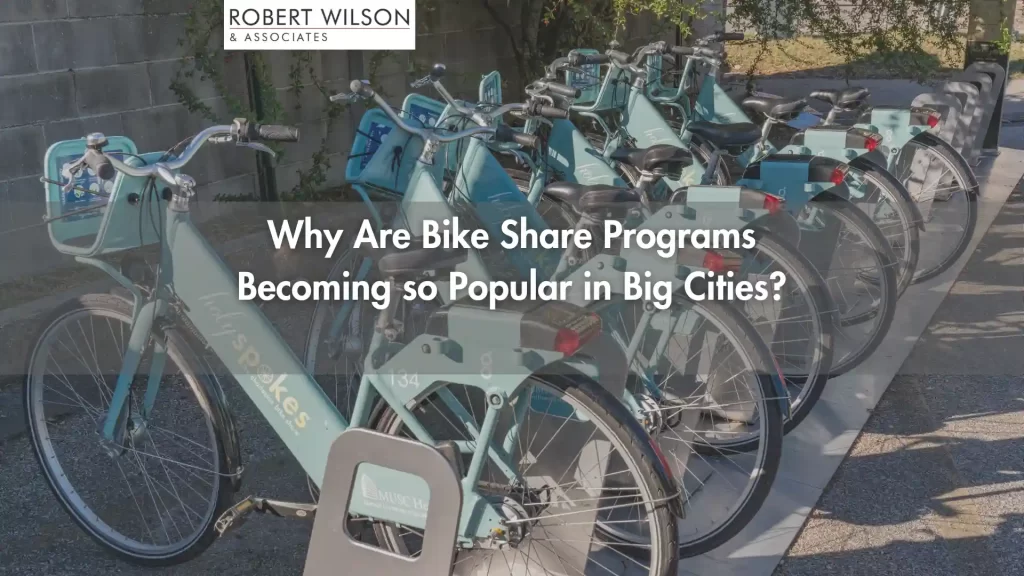
In recent years, cities in Minnesota and across the country have seen a massive surge in the popularity of bike-share programs. You can see colorful bikes from providers such as Lime, Ofo, and Spin lining sidewalks or scattered around neighborhoods. These bike-share programs have transformed city transportation and offered an eco-friendly alternative to traditional methods.
That said, having more cyclists on the road does create certain risks for bike riders and others. Below, Robert Wilson & Associates discusses the pros and cons of bike share programs, how these programs work, and what cities and cyclists can do to promote safety.
Understanding Bike Share Programs
Bike-sharing programs can be broadly classified into two types:
- Dock-less or Free-floating: Users locate and unlock bikes electronically via a smartphone app, paying by the hour. Once they finish their ride, they lock the bike using the app. The flexibility of being able to pick up and drop off bikes anywhere makes this type highly appealing.
- Docked or Station-based: Docking stations are strategically placed around the city, allowing users to rent bikes for free or a nominal fee. Users access bikes by swiping their credit or debit card at the station. Companies like Citibank often sponsor these programs, and they have made biking accessible to both tourists and residents alike.
Factors Contributing to the Popularity of Bike Share Programs
The explosive growth of bike share programs is largely due to several factors that make them an attractive choice for urban residents and visitors:
- Environmental Benefits: Biking helps reduce carbon emissions, traffic congestion, and noise pollution, contributing to greener, more sustainable cities.
- Health Benefits: Cycling offers excellent cardiovascular exercise and promotes healthy lifestyles, reducing the risk of chronic diseases.
- Economic Benefits: Bike sharing is a cost-effective alternative to owning a car or using public transportation, making it ideal for low-income individuals or those looking to save money.
- Convenience: Bike-sharing programs are user-friendly, with easily accessible bikes and smartphone apps that simplify city navigation.
Safety Concerns and Bicycle Accidents
The rise of bike sharing has inevitably led to an increased risk of bicycle accidents. Several factors contribute to this risk:
- Bike Maintenance: Bike share bikes may not receive the same level of maintenance as privately owned bikes, potentially leading to accidents due to tire blowouts, brake failures, or other mechanical issues.
- Inexperienced Riders: Many novice riders use bike share programs, and their unfamiliarity with safe biking practices or city biking rules may lead to accidents involving other cyclists, pedestrians, or vehicles.
- Lack of Safety Gear: Bike share programs typically do not provide helmets or other safety gear, putting riders at risk of severe injuries in the event of an accident. It’s crucial to bring your own helmet when using a bike share program.
- Reckless Behavior: The convenience and affordability of bike sharing may encourage some users to take unnecessary risks, such as cycling under the influence of alcohol or drugs, riding on sidewalks, or ignoring traffic signals.
- Infrastructure Limitations: Although cities are working to improve cycling infrastructure, existing bike lanes and traffic signals may not be sufficient to accommodate the growing number of cyclists, increasing the likelihood of accidents.
Preventative Measures and Legal Support
 To minimize the risk of bicycle accidents, both cyclists and city authorities can take various preventative measures:
To minimize the risk of bicycle accidents, both cyclists and city authorities can take various preventative measures:
- Education and Awareness: Cyclists should familiarize themselves with safe biking practices and city biking regulations. Cities should promote cycling safety education through public awareness campaigns, instructional materials, and workshops.
- Infrastructure Improvements: City authorities should invest in better cycling infrastructure, such as expanding bike lanes, installing cyclist-friendly traffic signals, and implementing traffic-calming measures to ensure a safer environment for all road users.
- Regular Maintenance: Bike share companies must ensure regular maintenance checks and timely repairs of their fleet to minimize the risk of accidents due to mechanical failures.
- Encourage Helmet Use: While bike-share companies may not provide helmets, companies and city authorities can promote helmet use by offering discounts or incentives to riders who bring their own helmets.
- Collaboration with Law Enforcement: Bike share companies and city authorities should work closely with law enforcement to address reckless behavior and enforce cycling rules to reduce the occurrence of bicycle accidents.
In the unfortunate event of a bicycle accident, it’s crucial to have the support of an experienced bicycle accident attorney. The Minnesota bicycle accident lawyers at Robert Wilson & Associates have the training and experience to recover full compensation for your injuries. We take a collaborative approach to our cases to ensure you have the best chance possible of recovering the money you need. Call us today at (612) 334-3444 or visit our contact page for your free consultation.
Related Posts: